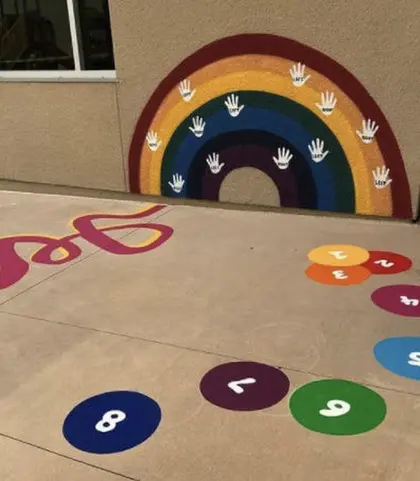Loading...

Using Sensory Paths to Improve Student Achievement
Jennifer Duffy
How does it work?
Sensory paths allow for vestibular and proprioceptive input, which can help a child regain self-control and focus. The vestibular system refers to our sense of balance and motion. The hub for our vestibular system is in the inner ear and provides information to our central nervous system. Children that are constantly jumping, climbing, or rocking are frequently seeking vestibular input in order to feel calm. The proprioceptive system tells us where our bodies are in space. Proprioceptive receptors are in our skin, muscles, and joints. When appropriately stimulated, these receptors communicate with our brain to help us feel grounded, safe, and secure. Similar to the extra input of a weighted blanket, proprioceptive activities help calm our brain and allow our energy to be spent elsewhere.
Dysregulated proprioceptive and vestibular systems frequently lead to behavioral issues including; excessive movement, lack of focus, and limited self-control. When students are experiencing these symptoms, there is little attention left for learning. Increasing proprioceptive and vestibular input can allow students to receive what they need in order to be able to return to the level of cognitive functioning needed in the classroom. Only when all systems are regulated and controlled can one put forth the concentration needed in order to learn new information.
Adding a sensory path or hallway is considered a sensory intervention. Many children, including those with autism, have difficulty processing their senses (5 senses plus proprioceptive and vestibular systems). When children experience difficulty integrating these senses, they may become overly sensitive to one sense (such as those that become
agitated when in noisy situations) or try to seek input (such as those that rock back and forth or spin repeatedly). Schools utilize many different sensory interventions, such as wearing a weighted vest, sitting on a ball, allowing fidgets, or wearing headphones in noisy settings. All of these things aim to help the student feel comfortable, safe, and ready to be their best self. Providing these sensory supports also teaches the body how to properly integrate the senses and allows these interventions to be gradually faded out.
Studies show that sensory interventions benefit all students, however, students with sensory processing deficits benefit the most from these types of support. These interventions can decrease behavioral issues and increase learning readiness. Sensory regulating activities can increase arousal for students that seem tired or unexcited while calming students that are overstimulated or appear hyper. A study on elementary students showed that integrating sensory based movements into the school day had a positive effect on all academic areas when compared to a control group. Additionally, physical movement helps supply the brain with dopamine, which assists with processing and communication.
Sensory hallways, sometimes called sensory paths, are designed to meet the needs of students with sensory integration difficulties. Educators and therapists are finding, however, that these spaces have potential benefits for a wider variety of students.
What is a sensory path?
A sensory path typically combines elements of hopscotch and an obstacle course. Different components are arranged in a sequence that challenges different areas of the brain and allows students to release energy and tension. These spaces can be indoor (frequently in a hallway) or outdoor. A child can be allowed to access the sensory path as a brain break or when feeling overwhelmed. Some schools choose to build these paths in frequently used hallways so all students have the opportunity to use it as they walk from class to class. Activities such as jumping on one foot or walking on their tip toes are popular ways to provide sensory input while maintaining some sort of order among students in between classes.
What is included in a sensory path?
A sensory path needs to have a variety of activities that stimulate different areas of the brain. Consider wall space as well as floor space when thinking about how to engage different areas of the body and brain. On the walls, it is helpful to hang panels of different textures. As students drag their hands along the wall when walking, they receive input from a variety of textured surfaces. Academic skills can also be integrated, such as a sight word wall that invites kids to jump and tap a word while saying it aloud. On the floor, arrows or lines can be laid using duct tape or pre-made floor decals. Signs that say something like, “Touch your toes and jump 4 times” can be mounted to the floor or the wall. Another idea is to place handprints on the wall with the words, “Push Here”. Hand and foot prints can be taped to the floor encouraging students to bear crawl on all fours. Any prompts to get students to jump, spin, stomp, clap, etc. are fun ways to get students moving and integrating their senses.
References:
Barker, H. (2020). About Us. The Sensory Path. Retrieved July 11, 2022, from https://thesensorypath.com/about-us/
Bolger, E. (2019, August 8). Movement and Mindful Hallways: Creating a Culture of Movement. Physical and Health Education America. Retrieved July 11, 2022, from https://www.pheamerica.org/2019/movement-and-mindful-hallways-creating-a-culture-of-movement/
Centers, C. I. P. T. (2021, July 27). Increasing sensory opportunities and movement as many kids head back to school. CI Therapies. Retrieved July 11, 2022, from https://www.citherapies.com/blog/increasing-sensory-opportunities-and-movement-as-many-kids-head-back-to-school/
Tejeda, B. (2022, January 4). How to create your own sensory path. Tejeda's Tots. Retrieved July 11, 2022, from https://www.tejedastots.com/how-to-create-your-own-sensory-path/
Weiss, MS, OTR/L, A. (2022, February). Sensory Hallways Help Refocus Attention and Learning. Fun and Function. Retrieved July 11, 2022, from https://funandfunction.com/blog/sensory-hallways-help-refocus-attention-and-learning
Photo source: https://www.weareteachers.com/sensory-path/
Sensory paths and hallways are making their way into early childhood and elementary schools everywhere. The benefits of this intentional movement help students focus, learn more, integrate their senses and have better behavior.
Teachers report that students return to class with higher levels of learning readiness and participation after utilizing these spaces. Sensory paths, yet again, demonstrate the clear connection between purposeful movement and student achievement.